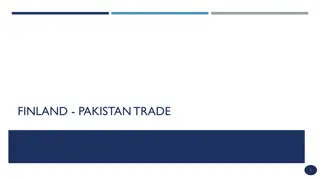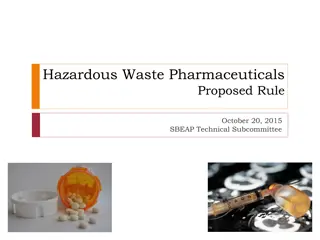Understanding Waste Management and its Environmental Impact in Pakistan
In Pakistan, approximately 20 million tons of solid waste is generated annually, with Karachi alone producing over 9,000 tons of municipal waste daily. Waste is defined by the Basel Convention as substances intended for disposal, encompassing various types such as solid and liquid wastes. Classification includes municipal solid wastes, biomedical wastes, and industrial wastes among others, highlighting the importance of proper waste management practices.
Download Presentation

Please find below an Image/Link to download the presentation.
The content on the website is provided AS IS for your information and personal use only. It may not be sold, licensed, or shared on other websites without obtaining consent from the author. Download presentation by click this link. If you encounter any issues during the download, it is possible that the publisher has removed the file from their server.
E N D
Presentation Transcript
Waste Management Environmental Health
Gravity of Problem! In Pakistan roughly 20 million tons of solid waste is generated annually With annual growth rate of about 2.4 percent Karachi, largest city in the country, generates more than 9,000 tons of municipal waste daily
What is a waste? Waste according to the Basel convention (1989): Wastes are substances or objects which are disposed or are intended to be disposed or are required to be disposed of by the provisions of national laws Disposal means any operation which may lead to resource recovery, recycling, reclamation, direct re-use or alternative uses
Continue Wastes may be generated during the extraction of raw materials, the processing of raw materials into intermediate and final products, the consumption of final products, and other human activities Residuals recycled or reused at the place of generation are excluded
Types of waste Solid wastes: wastes in solid forms, domestic, commercial and industrial wastes Examples: plastics, Styrofoam containers, bottles, cans, papers, scrap iron, and other trash Liquid Wastes: wastes in liquid form Examples: domestic washings, chemicals, oils, waste water from ponds, manufacturing industries and other sources
Classification of wastes according to their origin and type Municipal Solid wastes: Solid wastes that include household garbage, rubbish, construction & demolition debris, sanitation residues, packaging materials, trade refuges etc. are managed by any municipality. Bio-medical wastes: Solid or liquid wastes including containers, intermediate or end products generated during diagnosis, treatment & research activities of medical sciences. Industrial wastes: Liquid and solid wastes that are generated by manufacturing & processing units of various industries like chemical, petroleum, coal, metal gas, sanitary & paper etc.
Classification of wastes according to their origin and type Agricultural farming activities. biodegradable. Fishery wastes: Wastes generated due to fishery activities. These are extensively found in coastal & estuarine areas. Radioactive wastes: Waste containing radioactive materials. Usually these are byproducts of nuclear processes. Sometimes industries that are not directly involved in nuclear activities, may also produce some radioactive wastes, e.g. radio- isotopes, chemical sludge etc. wastes: Wastes These substances are mostly generated from
Classification of Wastes according to their Properties Bio-degradable can be degraded (paper, wood, fruits and others) Non-biodegradable cannot be degraded (plastics, bottles, old machines,cans, styrofoam containers and others)
What if waste is not managed properly??
Solid Waste Management Environmental Health
Solid Waste Hierarchy Source Reduction Avoidance Recycling Materials recovery Or transform to a product Energy Recovery Lowest in hierarchy Landfilling
Solid Waste Disposal Landfills Incineration Source reduction Composting Recycling
Land Fills It is a site for the disposal of waste materials by burial and is the oldest form of waste treatment Historically, landfills have been the most common method of organized waste disposal and remain so in many places around the world
Continue Confine waste to as small an area as possible Compact waste to reduce volume Cover waste (usually daily) with layers of soil
Leachate It is water that has percolated through a solid and leached out some of the constituents Extensive efforts are made to capture and treat leachate from landfills before it reaches groundwater but Engineered liners always have a lifespan, eventually, every landfill liner will leak
Incineration A waste treatment technology, which includes the combustion of waste for recovering energy, is called as incineration Incineration coupled with high temperature waste treatments are recognized as thermal treatments
Continue Incineration can be use to generate electricity 4.8 percent of the electricity as is consumed by Danish nation was produced by incineration Advantages?? Disadvantages??
Source Reduction Source reduction involves activities designed to reduce the volume, mass, or toxicity of products throughout the life cycle It includes the design and manufacture, use, and disposal of products with minimum toxic content, minimum volume of material, and/or a longer useful life
Resource Recovery Resource recovery is the selective extraction of disposed materials for a specific next use Such as recycling, composting or energy generation In order to extract the maximum benefits from products
Recycling Recycling is the process of converting waste materials into reusable materials and objects Recycling can prevent the waste of potentially useful materials Reduce the consumption of fresh raw materials, thereby reducing: Energy usage, air pollution (from incineration) and water pollution (from landfilling).
Recycling-Steps Collection: A number of different systems have been implemented to collect recyclates from the general waste stream Sorting: Manual or Automatic It is not always to prepare a final product but it can also a raw
Composting Decomposition: A natural process of recycling It is basically for biodegradable waste Almost 50% waste is organic
Hazardous Wastes Hazardous Wastes Dangerous by-products of industrial, business, or household activities for which there is no immediate use. Numerous types and forms: Heavy metals Organic wastes (toxic) Old Computers Batteries Liquids, solids, sludge Explosives Radioactive wastes
Continue Landfills are not recommended, however cave or underground mine can be used Recycling e.g. lead batteries Portland cement Pyrolysis (very high temperature treatment)
E-Waste Electronic products nearing the end of their "useful life Computers, televisions, VCRs, stereos, copiers, and fax machines are common electronic products Many of these products can be reused, refurbished, or recycled
What should be done? 3 R Donate Education Outreach Programs
Continue 1. construction of backyard compost pit 2. construction of storage bins where recyclable and reusable materials are stored by each household 3. construction of storage centers where recyclable and reusable materials collected by the street sweepers are stored prior to selling to junk dealers 4. maintenance of cleanliness in yards and streets 5. greening of their respective areas 6. encouraging others to join























